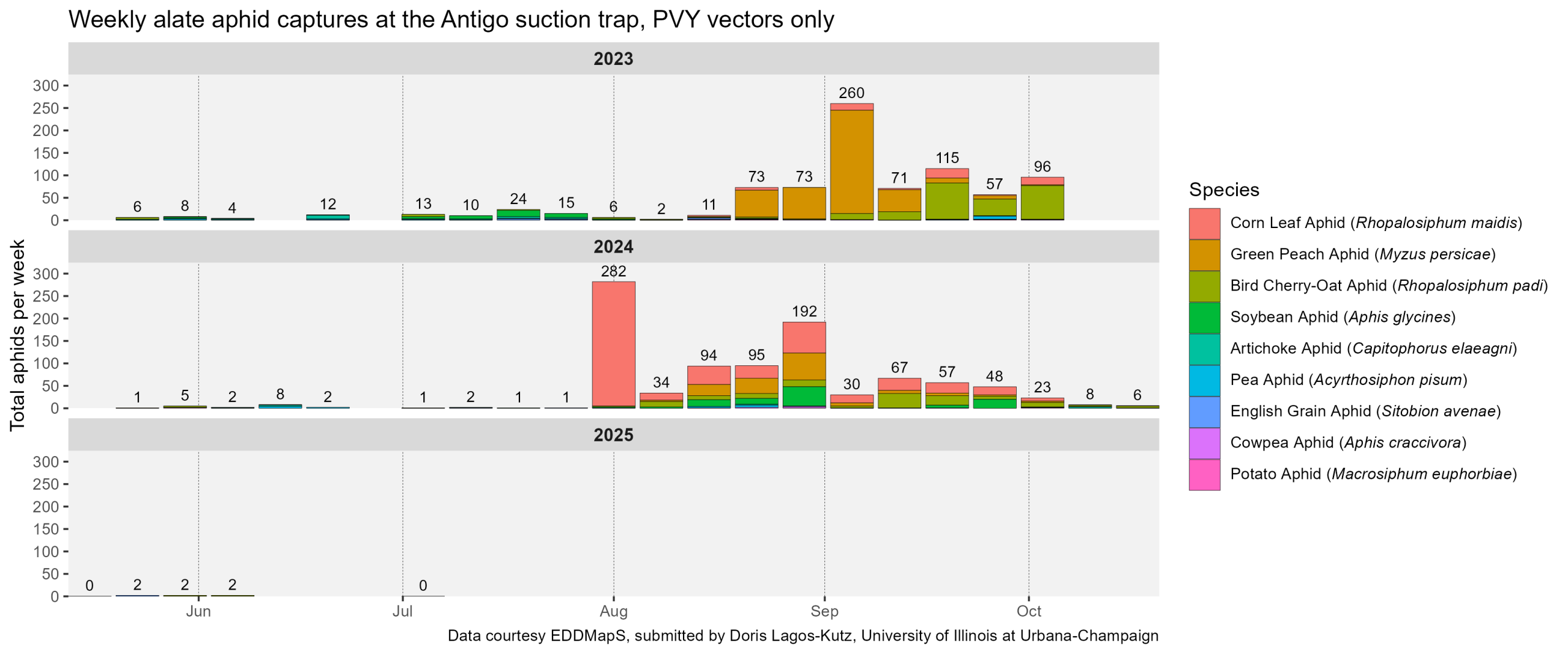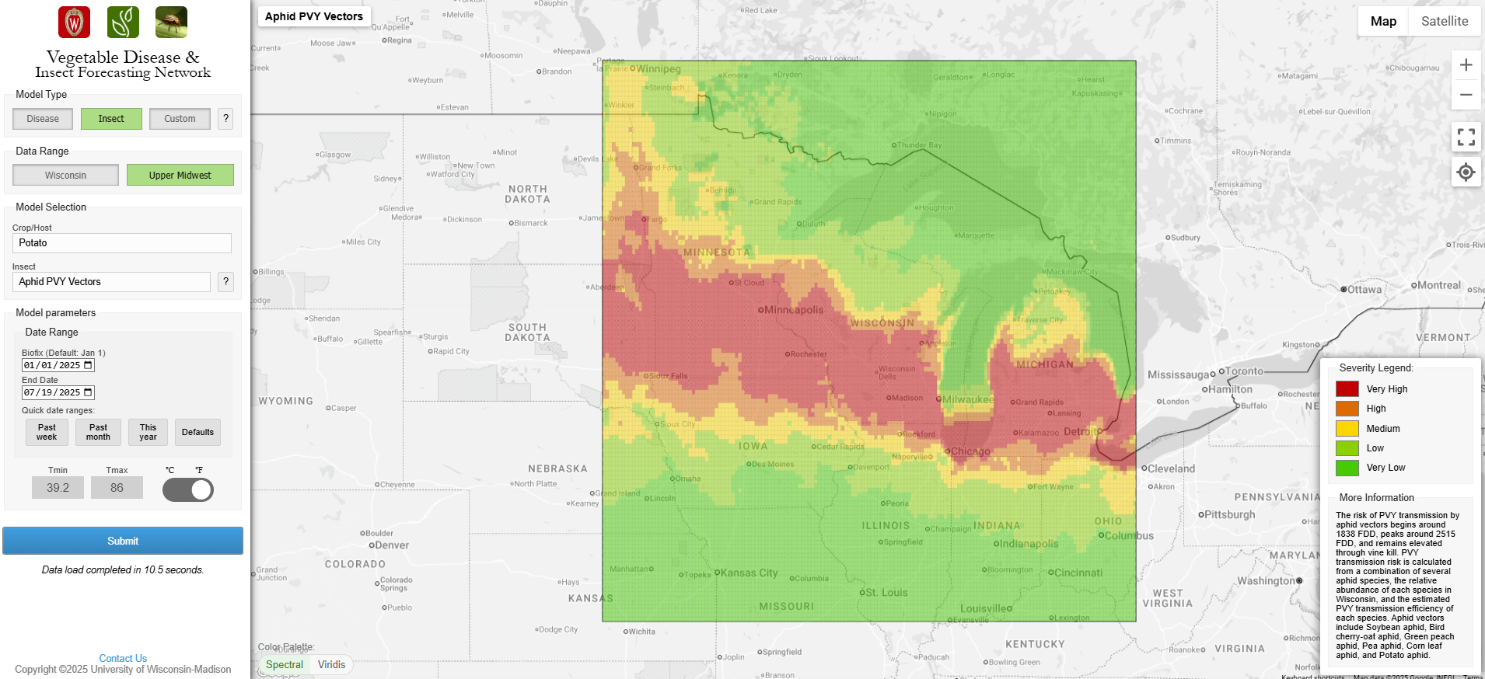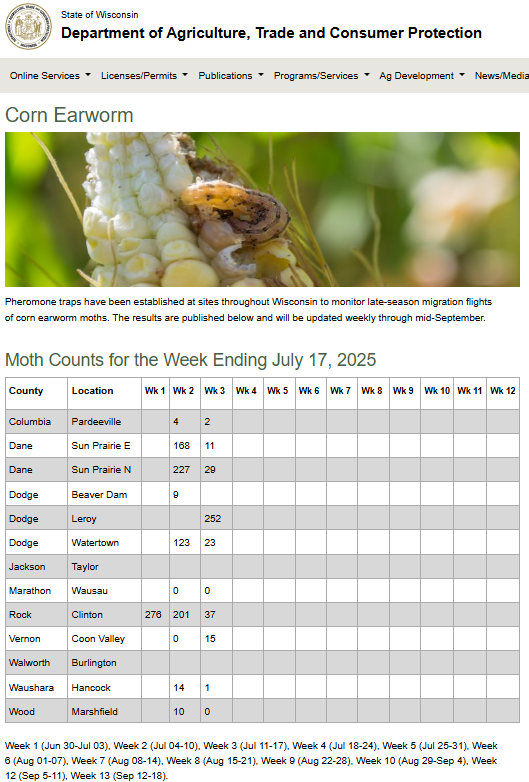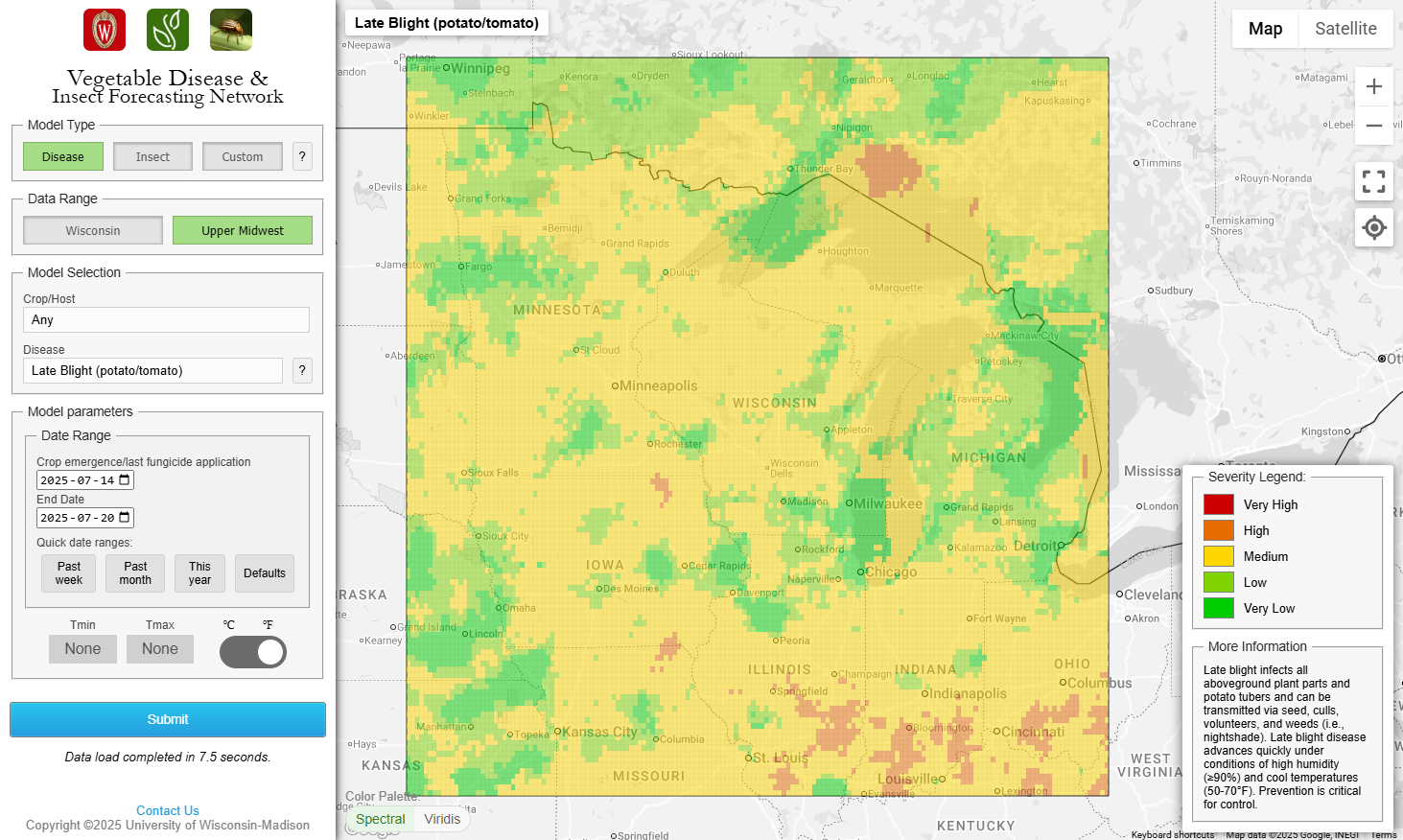
In This Issue:
- Potato Virus Y updates and management
- Corn Earworm updates and management
- Disease forecasting updates for potato early blight and late blight
- Cucurbit downy mildew updates
- Onion diseases and their prevention
Vegetable Insect Update – Russell L. Groves, Professor and Department Chairperson, UW-Madison, Department of Entomology, 608-262-3229 (office), (608) 698-2434 (cell), e-mail: rgroves@wisc.edu. Vegetable Entomology Webpage: https://vegento.russell.wisc.edu/
Potato virus Y and management. Aphid species that colonize potatoes (Green peach aphid (GPA) and Potato aphid) continue to be observed in fields over much of central and northern potato production areas. Small numbers of wingless, potato colonizing aphids have been detected in Adams, Columbia, Langlade, Portage, and Waushara counties, and these initial colonists were revealed by scouting. The Aphid Suction Trap Network reported first captures of GPA this past week (Jul 13-20), which is very consistent with the model predictions illustrated in the last newsletter.
At the Langlade County Research Station Field Day (July 17), aphid captures from the suction trap network were shared with participants (see illustrations below). Notably, many GPAs were captured in 2023-2024 during the latter half of the production season. Presumably, these (past year’s) captures reflect the transmission that resulted in elevated levels of Potato virus Y in recent years.

In 2025, the amount of PVY inoculum that has been planted in the Antigo flats seed production region as at an all-time high. For this reason, together with the initial detections of GPA in the potato production regions of the state, it is important to consider your virus management plans for the remainder of the season. Risk predictions from the Vegetable Disease and Insect Forecasting Network also illustrate the need to be vigilant and plan for the control of virus transmission.
For most aphid chemical management tools, timing of application occurs with the appearance of the first, small colonies of potato-colonizing aphids. Spraying for colonizing aphids can reduce the spread of PVY within the field. Spray only when scouting indicates aphid populations have become established and scouts can identify small colonies of apterous (wingless) aphids. Critical factors affecting the efficacy of these spray applications include timing, application conditions and coverage. The green peach aphid, potato aphid, and (to a lesser extent) buckthorn aphid will colonize and reproduce on potato and are efficient vectors of PVY. Systemic insecticides applied at planting are critical components of early generation seed potato protection, however, they lose efficacy by mid-season.

Corn earworm – (https://vegento.russell.wisc.edu/pests/corn-earworm/)
Pheromone captures (as reported from the Wisconsin Home Pest Survey) continue to confirm elevated numbers of adult moths over the past two weeks in select locations. These captures are likely to increase in the coming weeks I central and northern portions of the state as the second generation of adult moths are expected to be present in these regions.

Once larvae enter the ear, they’re protected from insecticides. Therefore, treatment timing is critical, and control must be targeted at the adults, eggs, and young larvae before they’re protected. The amount of time for egg hatch varies with temperature, but during periods of hot summer days and nights, eggs can hatch within 24 hours after they’re laid. Thus, each day’s delay in treatment may reduce the number of clean ears by 10 to 15%.
Insecticides must be present on vulnerable silks when eggs hatch. The first application is the most critical and tank-mixes containing an ovicide (an egg killer) and a larvicide (eg. spinosad, spinetoram, chlorantraniliprole) are recommended. On sweet corn, treat every 3 to 4 days beginning when silks first appear and continuing until they are brown in color. Discontinue treatments 10 days before harvesting fresh market sweet corn as additional sprays will not improve product quality.
Amanda Gevens, Professor & Extension Vegetable Pathologist, UW-Madison, Dept. of Plant Pathology, 608-575-3029, gevens@wisc.edu, Lab Website: https://vegpath.plantpath.wisc.edu/.
Current P-Day (Early Blight) and Disease Severity Value (Late Blight) Accumulations will be posted at our website and available in the weekly newsletters. Thanks to Ben Bradford, UW-Madison Entomology for supporting this effort and providing a summary reference table: https://agweather.cals.wisc.edu/thermal-models/potato. A Potato Physiological Day or P-Day value of ≥300 indicates the threshold for early blight risk and triggers preventative fungicide application. A Disease Severity Value or DSV of ≥18 indicates the threshold for late blight risk and triggers preventative fungicide application. Data from the modeling source: https://agweather.cals.wisc.edu/vdifn are used to generate these risk values in the table below. I’ve estimated early, mid-, and late planting dates by region based on communications with stakeholders. These are intended to help in determining optimum times for preventative fungicide applications to limit early and late blight in Wisconsin.
|
|
Planting Date | 50% Emergence Date | Disease Severity Values (DSVs)
through 7/19/2025 |
Potato Physiological Days (P-Days)
through 7/19/2025 |
|
| Spring Green | Early | Apr 5 | May 10 | 33 | 539 |
| Mid | Apr 18 | May 14 | 33 | 511 | |
| Late | May 12 | May 26 | 30 | 454 | |
| Arlington | Early | Apr 5 | May 10 | 26 | 539 |
| Mid | Apr 20 | May 15 | 26 | 502 | |
| Late | May 10 | May 24 | 23 | 465 | |
| Grand Marsh | Early | Apr 7 | May 11 | 30 | 523 |
| Mid | Apr 17 | May 14 | 30 | 503 | |
| Late | May 12 | May 27 | 30 | 449 | |
| Hancock | Early | Apr 10 | May 15 | 30 | 489 |
| Mid | Apr 22 | May 21 | 30 | 463 | |
| Late | May 14 | June 2 | 30 | 408 | |
| Plover | Early | Apr 14 | May 18 | 25 | 463 |
| Mid | Apr 24 | May 22 | 25 | 457 | |
| Late | May 19 | June 7 | 25 | 367 | |
| Antigo | Early | May 1 | May 24 | 21 | 420 |
| Mid | May 15 | June 1 | 20 | 388 | |
| Late | June 1 | June 15 | 16 | 301 | |
| Rhinelander | Early | May 7 | May 25 | 17 | 408 |
| Mid | May 18 | June 8 | 17 | 330 | |
| Late | June 2 | June 16 | 13 | 289 | |
Late blight of potato/tomato. The usablight.org website (https://usablight.org/map/ now using Plant Aid) indicates no new confirmed reports of late blight on tomato or potato in the US this past week. There was a US-23 late blight strain type confirmation in Collier County FL in 2025 (now > month old). The site is not comprehensive.
Late blight has been confirmed on potatoes in Dufferin County Ontario Canada on July 17, 2025. The strain type/clonal lineage has not yet been identified, but recent detections in this part of Canada have been of the US-23 lineage. https://onvegetables.com/2025/07/17/late-blight-update-july-17th-2025/
This genotype/clonal lineage is generally still responsive to phenylamide fungicides meaning that Ridomil and Metastar fungicides (mefenoxam and metalaxyl) can still effectively control late blight caused by these strain types. We saw the accumulation of 0-7 DSVs across WI this past week, with the greatest accumulations in the central part of the state. All plantings of potatoes in Wisconsin, with the exception of the Rhinelander area, have reached the Blitecast threshold of 18 DSVs and should receive preventative fungicides for the management of late blight. Please find a fungicide listing for Wisconsin potato late blight management: https://vegpath.plantpath.wisc.edu/documents/potato-late-blight-fungicides/

Early blight of potato. Accumulations of P-Days were 54-63 over the past week, with P-Day 300 thresholds met for preventative fungicide treatment in potatoes across most of Wisconsin locations, except for Rhinelander. The earliest inoculum of Alternaria solani typically comes from within a field and from nearby fields. Once established, early blight continues to create new infections due to its polycyclic nature – meaning spores create foliar infection and the resulting lesion on the plant can then produce new spores for ongoing new infections in the field and beyond. Early-season management of early blight in potato can mitigate the disease for the rest of the season, especially since the earlier sprays tend to get best coverage and potential control of early infection. Early blight is active in central and southern WI. https://vegpath.plantpath.wisc.edu/diseases/potato-early-blight/
Fungicides can provide good control of early blight in vegetables when applied early in infection. Multiple applications of fungicide are often necessary to sustain disease management to the time of harvest due to the typically high abundance of inoculum and susceptibility of most common cultivars. For Wisconsin-specific fungicide information, please refer to the Commercial Vegetable Production in Wisconsin (A3422), a guide available here: https://cropsandsoils.extension.wisc.edu/articles/2025-commercial-vegetable-production-in-wisconsin-a3422/
For custom values, please explore the UW Vegetable Disease and Insect Forecasting Network tool for P-Days and DSVs across the state (https://agweather.cals.wisc.edu/vdifn). This tool utilizes NOAA weather data. Be sure to enter your model selections and parameters, then hit the blue submit button at the bottom of the parameter boxes. Once thresholds are met for risk of early blight and/or late blight, fungicides are recommended for optimum disease control. Fungicide details can be found in the 2025 Commercial Veg. Production in WI Extension Document A3422: https://cropsandsoils.extension.wisc.edu/articles/2025-commercial-vegetable-production-in-wisconsin-a3422/
Cucurbit Downy Mildew: This national cucurbit downy mildew information helps us understand the potential timing of arrival of the pathogen, Pseudoperonospora cubensis, in our region, as well as the strain type which can give us information about likely cucurbit hosts in WI – as well as best management strategies. Clade 1 downy mildew strains infect watermelon and Clade 2 strains infect cucumber. I am hosting a cucurbit (and basil) downy mildew sentinel plot at the UW Hancock Agricultural Research Station this summer. This ‘sentinel plot’ is a non-fungicide-treated collection of cucurbit plants observed weekly for disease symptoms. No downy mildew was seen on basil or cucurbits this past week at HARS. Additionally, I keep an eye on the downy mildew work of Dr. Mary Hausbeck at Michigan State University and include this information as relevant to WI https://veggies.msu.edu/downy-mildew-news/. This season, Clade 2 downy mildew spores were confirmed in several MI counties and downy mildew has been confirmed in commercial cucumber fields in 11 MI counties, now including the Bay County area. The disease was also reported in northern Ohio this past week on cucumber.
Onion Diseases. I have looked at several onion samples over the past week with a few inquiries about downy mildew. While our diagnostician Dr. Brian Hudelson and I have not yet seen this disease, the weather has been favorable and if you’re growing onions in a field with history of onion downy mildew, or in a field nearby a field with such history, it’s important to be observant and make appropriate preventative fungicides to limit this disease. Some of what we have confirmed: bacterial disease in bulb and new leaves and Alternaria pathogens. Please recall that we now have a Botrytis Leaf Blight predictive model available for onion at the UW Vegetable Disease and Insect Forecasting Network site to assist in preventative management of Botrytis.
Onion Downy Mildew – https://vegpath.plantpath.wisc.edu/diseases/onion-downy-mildew/
Written by Ariana Abbrescia, Amanda Gevens, Russell Groves, and Ben Bradford. The pathogen causing Downy mildew is a water mold or oomycete disease of alliums caused by Peronospora destructor. It causes irregular foliar lesions that begin as pale-green, then progress to yellow or brown necrotic tissue. Eventually, lesions coalesce and lead to the collapse of the leaf. During periods of high moisture, fuzzy, gray-to-violet sporangia appear on leaf surfaces. These symptoms can also be seen on seed stalks and flowers. Bulbs can be stunted and sponge-like during systemic plant infection and, when the disease infects the bulb itself, can become watery.
Primary Source: Infested soil, infected plant debris, and perennial alternate host plants
Spread: Airborne spores, wind currents, splashing water
Favorable Conditions: High humidity, moderate temperatures with an optimal temperature of 55ºF, high moisture

Infection & Disease Cycle
Peronospora destructor mainly overwinters in volunteer infected onions and those in cull piles as mycelium. It is also known to overwinter in perennial onion varieties, as well as soil-bound spores and plant debris. On nights with moderate temperatures and high humidity, overwintered mycelia produce spores (sporangia) that spread throughout the day via wind currents. These spores require free water, whether from rain, irrigation, or heavy dew to germinate and infect the plant, often beginning infection at the tops of leaves. Resulting lesions produce new sporangia and zoospores (swimming water spore borne out of the sporangia), which travel both down the leaves of individual plants and to new nearby plants via wind currents or splashing water.
Cultural Control
Scouting regularly allows early identification of disease before significant spread and damage. The following practices can also help prevent disease development:
- Plant resistant varieties when possible
- Rotate away from susceptible crops ( 3+ years)
- Plant in areas with good airflow
- Maintain proper spacing between plants
- Avoid overhead irrigation
- Maintain proper soil moisture
- Destroy plant debris, cull piles, volunteers
Chemical Control
For Wisconsin-specific fungicide information, refer to the Commercial Vegetable Production in Wisconsin (A3422), a guide available through the UW Extension Learning Store website. Or, for home garden fungicide recommendations, see Home Vegetable Garden Fungicides (D0062), a fact sheet available through the UW Plant Disease Diagnostic Clinic website. Always follow label directions carefully.
Resources
- Commercial Vegetable Production in Wisconsin (A3422) from the UW Extension Learning Store. This guide offers the latest recommendations for disease, insect, and weed management in Wisconsin’s most common commercial vegetable crops. Also included are lime and fertilizer recommendations as well as insect identification information and keys.
- UW Plant Disease Diagnostics Clinic. The University of Wisconsin-Madison/Extension Plant Disease Diagnostics Clinic (PDDC) provides assistance in identifying plant diseases and provides educational information on plant diseases and their control.
References
- Lorbeer, James, and John Andaloro. 1984. “Onions-Downy Mildew Fact Sheet.” 1984. http://vegetablemdonline.ppath.cornell.edu/factsheets/Onions_Downy.htm.
- Olis, Jim, and Brian Hudelson. 2021. “Downy Mildew | Plant Disease Diagnostics Clinic.” 2021. https://pddc.wisc.edu/2015/07/21/downy-mildew/.